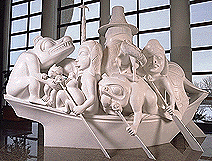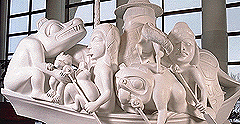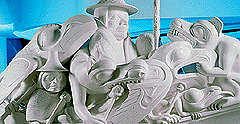Grand Hall tour
The Spirit of Haida Gwaii
The Spirit of Haida Gwaii features Raven and Eagle, the two
principal Haida lineages that are coequal and represent two halves of a
whole. The sculpture encompasses mythical creatures, animals, men and
women, who together symbolize not just one culture but the entire family
of living beings. The canoe is filled to overflowing with creatures
who bite and claw one another as they doggedly paddle along.
Commenting on where this boat may be heading, Bill Reid says:
There is certainly no lack of activity in our little
boat, but is there any purpose? Is the tall figure who may or may not
be the Spirit of Haida Gwaii leading us, for we are all in the same boat,
to a sheltered beach beyond the rim of the world as he seems to be or is
he lost in a dream of his own dreaming? The boat moves on, forever
anchored in the same place.

Spirit of Haida Gwaii, Bill Reid's largest and most complex
sculpture, is displayed at the river end of the Grand Hall. As if heading
for the shoreline of the coastal village, the Spirit of Haida Gwaii
represents a Haida canoe crammed with a bewildering variety of
paddlers
and passengers. The white sculpture is the original plaster pattern
used to cast the
bronze
sculpture at the Canadian
Embassy in Washington, D.C. The plaster-cast was acquired
by the Museum through the generosity of Maury and Mary Margaret Young of
Vancouver.
 From left to right, the creature sitting in the bow is Grizzly Bear, facing
Bear Mother.
Between them are their two Bear cub offspring,
creatures that grew out of a children's poem by A.A. Milne. Next are:
Beaver, who lived on the ocean floor hoarding all the fresh water
and fish in the world; Dogfish Woman, with a great hooked beak, gill
slits on her cheek, and a pointed head; and Mouse Woman, the traditional
guide to those who travel from the human world to the non-human realms of
Haida mythology.
From left to right, the creature sitting in the bow is Grizzly Bear, facing
Bear Mother.
Between them are their two Bear cub offspring,
creatures that grew out of a children's poem by A.A. Milne. Next are:
Beaver, who lived on the ocean floor hoarding all the fresh water
and fish in the world; Dogfish Woman, with a great hooked beak, gill
slits on her cheek, and a pointed head; and Mouse Woman, the traditional
guide to those who travel from the human world to the non-human realms of
Haida mythology.
 At the stern is the steersman, Raven; he seems intent on manoeuvring
the boat in a particular direction, but he may change course as his
whim dictates. Beneath Raven's wing is a human figure, the grudging
oarsman; he represents all the common people who labour to build
and rebuild, stoically obeying orders and performing tasks allotted
to them. Arched across the centre of the boat is Wolf, with his hind
claws in Beaver's back and his teeth in Eagle's wing. Beneath Eagle
is Frog. The prominent central figure is a shaman, the Haida chief
Kilstlaai. As a symbol of authority he holds a speaker's staff; on
the top of the staff is Killer Whale.
At the stern is the steersman, Raven; he seems intent on manoeuvring
the boat in a particular direction, but he may change course as his
whim dictates. Beneath Raven's wing is a human figure, the grudging
oarsman; he represents all the common people who labour to build
and rebuild, stoically obeying orders and performing tasks allotted
to them. Arched across the centre of the boat is Wolf, with his hind
claws in Beaver's back and his teeth in Eagle's wing. Beneath Eagle
is Frog. The prominent central figure is a shaman, the Haida chief
Kilstlaai. As a symbol of authority he holds a speaker's staff; on
the top of the staff is Killer Whale.
